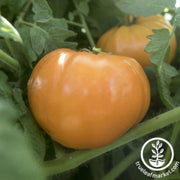Out Of Stock!
We will notify you when this product becomes available.
Tomato Seeds - Slicing - Goldie
85-100 Days to maturity (from transplant). Solanum lycopersicum. Goldie Tomato Seeds. Non-GMO, warm season annual, open-pollinated, heirloom, indeterminate, slicing tomato. Suitable for growing in garden plots, raised beds, and greenhouses. Very vigorous indeterminate vines huge golden slightly flattened globes. ~ 6,800 seeds/ounce.




Download Free Vegetable Growing Guide PDF
Growing Goldie Tomatoes in the Vegetable Garden
To cultivate vibrant Goldie Tomatoes, follow these planting guidelines for a successful growing season. Begin by starting the seeds indoors 7-9 weeks before the last spring frost date. Plant the seeds at a depth of 0.25 inches in well-draining, loose soil with a slightly acidic pH between 6.2 and 6.8. Ensure the soil is moisture-retaining but avoid excessive nitrogen content, which can lead to more foliage production than fruiting. Maintain a germination temperature between 65-85 F for 7-10 days until seedlings emerge. Once the threat of frost has passed, typically after the last spring frost, it's time to transplant your Goldie Tomato seedlings outdoors. Choose a sunny location with full sun exposure, as tomatoes thrive in warmer temperatures between 70-85 F. Allow 24-36 inches of spacing between plants and 36 inches between rows to accommodate the sprawling growth habit of indeterminate tomatoes.
Regularly monitor your tomatoes for common pests like tomato hornworms and aphids. Early detection and intervention can prevent infestations, and using companion plants like basil and marigolds can naturally deter certain pests. Maintain a balanced watering schedule, ensuring the soil remains consistently moist but not waterlogged. Mulching around the base of the plants helps retain moisture, suppress weeds, and regulate soil temperature. Watch for signs of nutrient deficiencies and consider supplementing with organic fertilizers rich in phosphorus and potassium to support fruit development. Given the indeterminate growth habit, provide sturdy support structures like cages or stakes to prevent sprawling and facilitate air circulation. Prune excess foliage to improve air circulation, reduce the risk of diseases, and channel the plant's energy into fruit production. Companion planting with herbs like basil not only deters pests but can also enhance the flavor of Goldie Tomatoes. Additionally, planting tomatoes alongside carrots, onions, and peppers can create a harmonious environment, benefiting each other's growth.
Harvesting Goldie Tomatoes
Goldie Tomatoes, with their bright yellow hue and mild flavor, are typically ready for harvest 85-100 days from transplant, making them a late-season delight. As an indeterminate variety, Goldie Tomatoes continuously produce fruit throughout the growing season. Determining the optimal harvest time involves observing the fruit's color and firmness. When the tomatoes develop a vibrant yellow color and yield slightly to gentle pressure, they are ripe for picking. To harvest, use clean, sharp garden shears or scissors to snip the tomatoes from the vine, leaving a short stem attached. This method prevents damage to the plant and ensures a clean cut. Be mindful not to tug or twist the fruit to avoid harming the plant. Regularly harvesting ripe tomatoes encourages the plant to focus on producing new fruit. Indeterminate tomatoes like Goldie often have a longer harvesting period, providing a steady supply of fresh tomatoes. Harvesting regularly, especially during the peak of ripeness, ensures a continuous yield and promotes further fruit development. Whether enjoyed fresh in salads, sandwiches, or as a standalone snack, Goldie Tomatoes reward your patience with a burst of late-season flavor.
About Goldie Tomato Garden Seeds
The Goldie Tomato, scientifically known as Solanum lycopersicum, boasts a rich history and heritage. While specific details about its origin are not widely documented, the tomato has been cherished since the 19th century. Its longevity in cultivation underscores its popularity and the appreciation it has garnered from generations of gardeners.
Goldie Tomato appears to have been bred for its distinctive traits, notably its mild flavor and vibrant yellow color. The breeding likely aimed to create a tomato variety with a unique appearance and taste, contributing to its widespread appeal in culinary applications. Additionally, its adaptability to warmer climates suggests that it may thrive in regions with higher temperatures, making it suitable for a variety of growing environments.
Beyond its appealing color and mild taste, Goldie Tomato has become a favorite for late-season harvesting. With a growth habit classified as indeterminate, the plant continues to produce fruit throughout the growing season, ensuring a prolonged harvest period. This feature makes it a valuable addition to gardens seeking a consistent supply of fresh, homegrown tomatoes.
Goldie Tomato can be successfully cultivated in container gardens, making it an excellent choice for individuals with limited space. The indeterminate growth habit, coupled with proper support such as stakes or cages, allows it to thrive in containers on patios, balconies, or small gardens. While hanging baskets may pose some challenges due to the plant's sprawling nature, creative trellising or vertical gardening techniques could potentially adapt Goldie to hanging basket cultivation.
Tips From Our Gardeners
"Consider implementing a "Tomato Tea" regimen to boost the overall health and flavor of your Goldie Tomato plants. Tomato Tea is a homemade, nutrient-rich fertilizer that provides essential elements for robust growth. Create the tea by steeping crushed eggshells, banana peels, and Epsom salt in water. The calcium from the eggshells strengthens the plant's cell walls, while banana peels contribute potassium, promoting flower and fruit development. Epsom salt provides magnesium, aiding in nutrient absorption. Use this organic concoction as a periodic supplement to your standard fertilization routine, and watch your Goldie Tomatoes thrive with enhanced vigor and a flavor that truly stands out."
 |
- Chelsea Hafer, True Leaf Market Writer |
Other Resources
Goldie Tomato Seeds Per Package:
- 300 mg packet - Approximately 65 Seeds
- 0.25 oz - Approximately 1,700 Seeds
- 1 oz - Wholesale - Approximately 6,800 Seeds
- 4 oz - Wholesale - Approximately 27,200 Seeds
- 1 lb - Bulk Seeds - Approximately 108,800 Seeds
Non-GMO Goldie Tomato seeds are available for Fast Free Shipping on qualifying orders.
Basic Info
| Latin Name: | Solanum lycoperscium (previously Lycopersicon esculentum) |
| Tomato Type: | Slicing - Larger, round tomatoes, the size of your fist or larger. |
| Goldie Tomato Color: | Yellow |
| Goldie Tomato Flavor: | Mild |
Growing Info
| Hardiness Zone: | 2, 3, 4, 5, 6, 7, 8, 9, 10, 11 Annual: Not intended to overwinter |
| Days to Maturity: | 85-100 (from transplant) |
| Days to Germination: | 7-10 |
| Seeding Depth: | 0.25 inch |
| Plant Spacing: | 24-36 inches |
| Row Spacing: | 36 inches |
| Plant Height: | 48-72 inches |
| Growth Habit: | Indeterminate - Indeterminate tomatoes are vine-type plants that sprawl (requiring a cage or trellis to support them) and continue to grow throughout the season. Indeterminate tomato plants will continue to produce tomatoes for the rest of the season, so you can harvest continually. |
| Soil Preference: | Well-draining, loose (sandy loam), slightly acidic (6.2 to 6.8), and moisture retaining. Too much nitrogen in the soil may lead to more foliage production and less fruiting. Tomatoes like more phosphorus and potassium than other vegetables. |
| Temperature Preference: | Warmer (70-85 F) |
| Light Preference: | Full Sun |
Other
| Direct Sow: | No |
| Start Indoors: | Yes. Start Indoors 7-9 weeks before your last spring frost date. |
| Plant Width: | 24 inches |
| Plant Spread: | 24 inches |
| Growth Speed: | Late - Ready to harvest from 81 days or more from transplant. Difficult, if not impossible, to get a tomato by the 4th of July with these varieties. They are good late-summer to early-fall producers for most USDA Zones. |
| Germination Temperature: | 65-85 F |
| Pests and Diseases: | Common pests known to harm tomato plants, in general, include the tomato hornworm, cutworm, aphids, flea beetles, tomato fruit worms, and whiteflies. Also, watch for common diseases such as blossom end rot, fusarium wilt, powdery mildew, verticillium wilt, late blight, bacterial canker/spot, and tobacco mosaic virus. Most of these can be prevented by maintaining a regular watering schedule and avoiding overwatering. Regularly check your plants for pest damage throughout the season. For treating pest and disease problems, we recommend using an organic neem-based product. |
| Garden Size: | Greenhouse, Garden Plot, Raised Bed |
| Tomato Use: | Salads, fresh eating, slicing |














